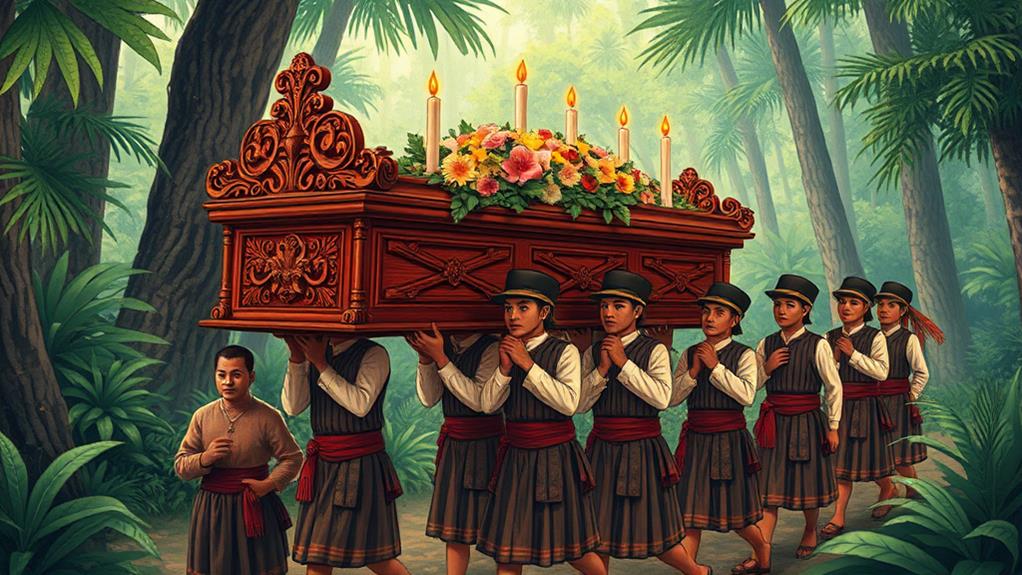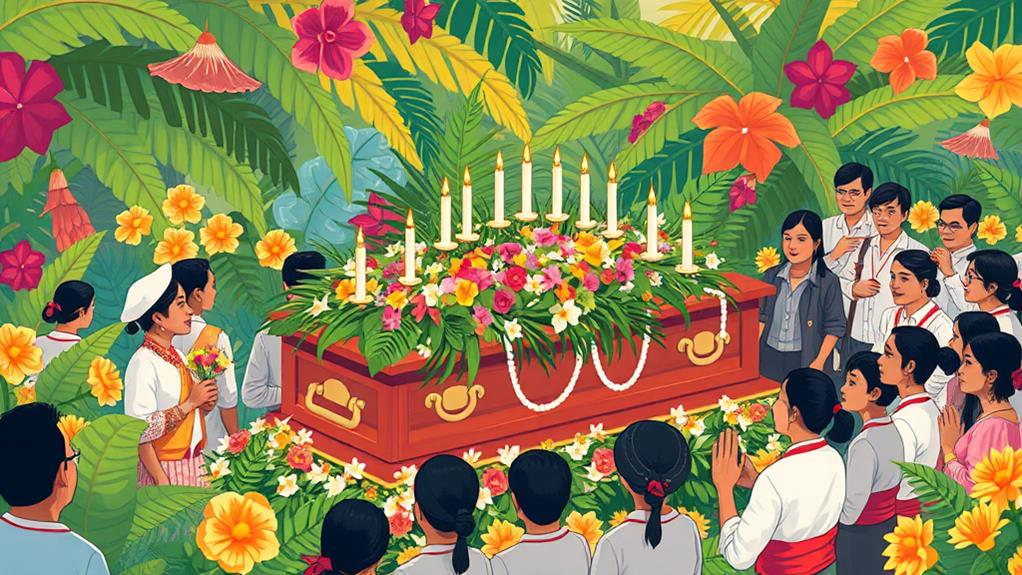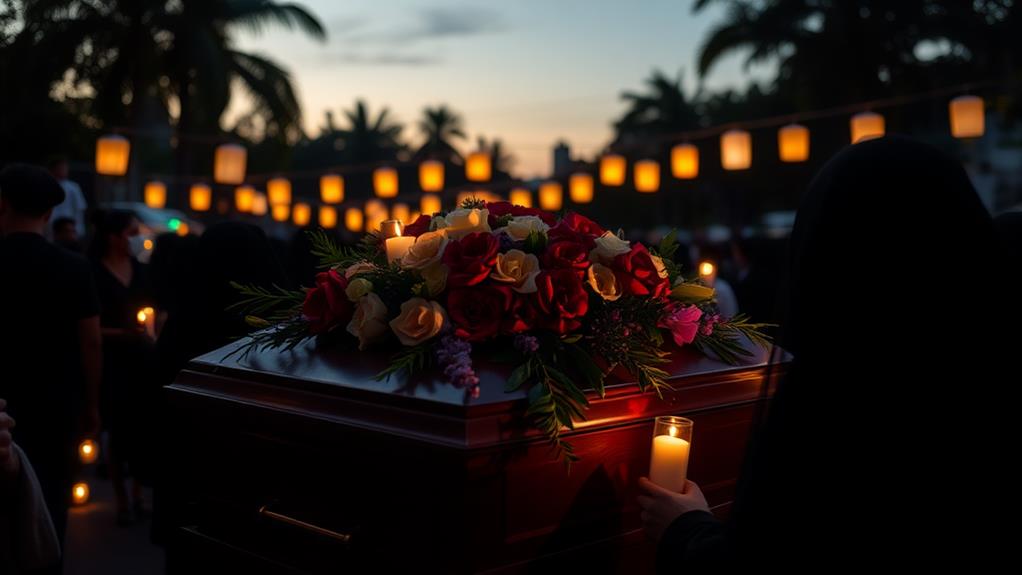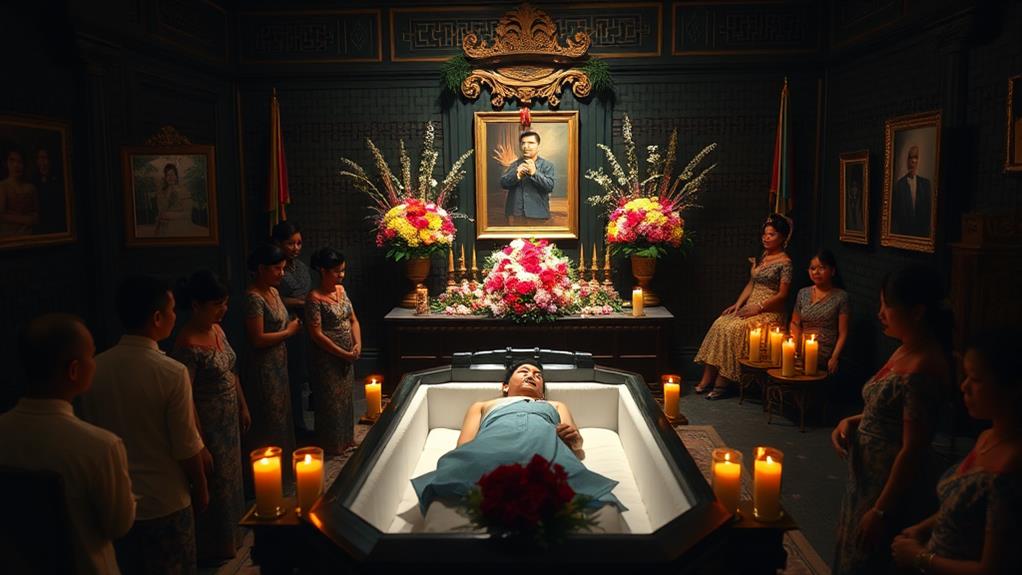Funeral rites in the Philippines are a unique blend of Catholic and indigenous traditions. These traditions honor the departed with a deep sense of cultural significance and spiritual reverence.
A key part of these rites is the wake, which lasts from three to nine days and serves as a gathering for sharing stories, honoring the deceased, and supporting grieving families.
Regional customs add diversity to these funeral rites. For example, in Sagada, coffins are suspended from cliffs, while in Apayao, bodies are buried beneath kitchen floors.
These rituals guide the soul's journey to the afterlife and are an integral part of the country's rich cultural heritage.
Historical Roots of Filipino Funerals

The Philippines had a rich cultural heritage of pre-Hispanic beliefs that shaped the country's funeral practices. These ancient beliefs centered on life after death and ancestral veneration, laying the groundwork for modern funeral customs. For example, the concept of life after death influenced the practice of offering food and drinks to the deceased during wakes.
The introduction of Catholicism during Spanish colonization significantly influenced Filipino funeral customs. The merger of indigenous beliefs with Christian rituals resulted in unique funeral customs that honor the dead.
Traditional funerals often involve extended wakes lasting several days, where family and friends come together to share stories and offer communal support.
Regional variations in burial practices reflect local customs. Specific rites and rituals are integral to the cultural identity of different communities. For instance, in some regions, the deceased is buried with personal belongings and items needed for the afterlife.
The 40-day period following a death is crucial for the soul's transition. Various observances are aimed at ensuring safe passage to the afterlife.
During this period, families often hold novenas, a series of nine-day prayer rituals, to guide the soul through its transition.
Traditional Funeral Practices
Traditional Filipino Funerals: A Blend of Cultural Heritage and Spiritual Practices
Traditional Filipino funerals are deeply rooted in the country's cultural heritage, with customs and practices that have been passed down through generations.
The wake, which typically lasts several days, serves as a time for family and friends to gather, pay respects, and share stories about the deceased. During this period, the deceased is usually placed in an elaborately decorated coffin, accompanied by flowers and a framed photo.
Key Aspects of Traditional Filipino Funerals
The Wake: A gathering of family and friends to pay respects and share stories about the deceased, providing community support and connection.
Spiritual Rituals: Reciting prayers and hymns, including the Rosary, to honor the deceased and seek comfort.
Food: Relatives and friends bring dishes to share, fostering community support and connection.
These customs blend indigenous beliefs and practices with Catholic influences, resulting in a unique and meaningful way to honor loved ones.
Throughout the funeral rites, prayers and spiritual rituals play a central role, providing comfort and solace to the grieving family.
Regional Burial Customs

Regional Burial Customs in the Philippines
The Philippines is home to a diverse array of regional burial customs, reflecting the country's rich cultural heritage.
Hanging Coffins in Sagada
In Sagada, the deceased are placed in hanging coffins at high altitudes to aid their journey to the afterlife.
The coffin's attire and design reflect the deceased person's social class, showcasing the community's respect for the individual.
Burial Under the Kitchen in Apayao
In Apayao, the deceased is buried under the kitchen, symbolizing warmth and familial ties.
Before burial, the family and community wash and dress the body, offering prayers and making offerings.
Bilaan Burial Custom
The Bilaan people wrap the deceased in tree bark and keep the body at home for three weeks before burying it in a carved tree trunk hung in the forest canopy.
"Chair-Turner" Burial Custom in Benguet
In Benguet, the deceased is blindfolded and tied to a chair, with elders chanting their biography to guide them to heaven.
This unique custom is a testament to the community's emphasis on honoring the spirit of the dead.
Funeral Customs in Cebu
In Cebu, funeral customs include a nine-day rosary recitation, with superstitions surrounding mourning attire and household chores to prevent bad luck.
These regional burial customs showcase the Filipino culture's emphasis on honoring the spirit of the dead and maintaining connections with the living.
Cultural Significance of Death
Death rituals in the Philippines reflect a unique blend of Catholic and indigenous traditions. This blend is evident in the emphasis on the spiritual journey of the deceased and the connection between the living and the dead.
Filipino funeral traditions prioritize a nine-day mourning period, during which family members and friends come together to support each other in their grief. This communal space allows them to honor the deceased while guiding their spirit to the afterlife.
Customs like lighting candles and conducting nightly prayers and rituals are essential to ensuring a safe passage for the deceased. These practices are believed to maintain spiritual harmony during mourning.
Superstitions surrounding death, such as prohibiting sweeping and bathing in the presence of the deceased, highlight the importance of avoiding disruptions to this harmony.
Festivals like All Souls' Day reinforce the significance of remembering and honoring departed loved ones. These collective remembrances strengthen community bonds and underscore the cultural importance of death in the Philippines.
Mourning Rituals and Practices

Filipino Funeral Traditions: Mourning Rituals and Practices
In Filipino funeral traditions, mourning rituals and practices play a vital role in honoring the deceased and supporting the grieving family. A wake lasting several days is a common practice, during which family and friends gather to pay respects, share stories, and engage in nightly prayers to honor the deceased.
Cultural Practices to Avoid
During the mourning period, certain activities are prohibited, such as bathing, combing hair, and sweeping, as these are believed to attract bad luck or disturb the spirit of the deceased.
Signs of Respect
Mourners often wear black clothing, neckerchiefs, and veils as a sign of respect for the deceased.
Guiding Spirits to the Afterlife
In some communities, specific customs like lighting bonfires are practiced to guide spirits to the afterlife.
Duration of Mourning
The duration of mourning varies by region, with some communities observing extended periods, like nine days, to connect the living with the spiritual realm.
Food Offerings and Shared Meals
During funeral services, food offerings and shared meals among attendees reflect the cultural value of hospitality even in times of grief.
Historical Artifacts and Innovations
Filipino Funeral Traditions: A Rich Cultural Heritage
Filipino funeral traditions are deeply rooted in the country's history and cultural identity.
Historical Artifacts
Manunggul Jars are intricately designed pottery that symbolize a spiritual journey, featuring a cover with two men in a boat.
Maitum Anthropomorphic Pottery are unique burial jars with head-shaped covers and detailed carvings that express various emotions.
Burial Jars reflect the belief in life after death and continued existence.
These artifacts highlight the cultural significance of burial customs in the Philippines. The use of anthropomorphic pottery and burial jars is distinct to Southeast Asia, demonstrating the rich historical interplay between indigenous burial practices and spiritual beliefs.
Innovations in Burial Practices
Over time, innovations in burial practices have included the transition from using natural materials like tree bark to more elaborate coffins and tombs, often reflecting the deceased's social status.
The decline in traditional burial artifacts can be attributed to the spread of Catholic influence during Spanish colonization, which introduced new burial customs and religious practices.
Regional Variations in Customs

Regional Variations in Filipino Funeral Traditions
Filipino funeral traditions vary across regions, shaped by local beliefs and cultural identities. Each region has its unique twist on honoring the departed.
In Apayao, the kitchen becomes a sacred space, where the deceased is buried beneath the kitchen floor to symbolize warmth and familial ties. This practice emphasizes the importance of family and the role of the kitchen as a gathering place.
In Sagada, coffins are suspended on cliffs, a traditional practice known as Hanging Coffins. This is believed to assist the deceased's spirit in its journey to the afterlife. This unique method allows the deceased to be closer to the heavens and is a testament to the community's strong spiritual beliefs.
In Benguet, the deceased is blindfolded and tied to a chair, a practice known as Dead Sitting Pretty. This emphasizes the ongoing connections between the living and the dead, ensuring the deceased remains a part of the community even in death.
Other regional variations include the Bilaan people's preservation of the dead in tree bark, which serves as a natural coffin, and the Cebuano's blend of Catholic and indigenous beliefs, marked by reciting the rosary for nine days and prohibiting certain activities.
These diverse customs showcase the richness of Filipino burial practices, each one honoring the departed in its own unique way.
Cultural Practices Surrounding Death
Death is a universal experience, but cultural practices surrounding it in the Philippines are unique and deeply rooted in the country's history and heritage.
Funeral practices and burial customs are heavily influenced by Catholicism. For example, rituals often include prayers, hymns, and the recitation of the Rosary for nine days following the death.
A wake is held, typically lasting from three to nine days, providing a communal space for family and friends to gather, share stories, and offer condolences to the bereaved relatives of the deceased.
Superstitions play a significant role during the wake. For instance, there are prohibitions on bathing and combing hair in the deceased's presence, and avoiding sweeping the home to prevent bad luck.
The forty-day period following a death is considered crucial for the soul's transition, with specific rituals conducted on the fortieth day to facilitate forgiveness and safe passage to the afterlife.
Community support is paramount in Filipino funeral practices. Traditions like Abuloy, or financial donations, help alleviate the financial burdens of burial expenses for grieving families.
Wake and Funeral Rituals

Filipino Funeral Traditions: A Communal Farewell
In Filipino culture, the wake is a vital transitional phase between life and death, where family and friends gather to pay respects and share memories of the deceased. The deceased's body is displayed in an elaborate coffin, typically placed in a prominent area of the home or funeral parlor, allowing mourners to visit and pay their respects.
The Wake: A Time for Community and Reflection
The wake typically lasts from three days to over a week, during which nightly prayers, including the recitation of the Rosary, are conducted to guide the spirit of the deceased towards the afterlife.
Food plays a significant role in wake customs, with relatives and friends bringing dishes to share, fostering a sense of community support during mourning.
From Wake to Funeral and Burial
Once the wake concludes, a funeral Mass is held, culminating in burial.
Regional burial customs influence the rituals performed, such as the sprinkling of holy water and flower offerings at the grave. These rituals demonstrate the strong sense of community and respect that Filipinos have for their dearly departed.
What are the similarities and differences between Filipino funeral rites and wedding customs?
Filipino funeral rites and wedding customs both hold significant cultural importance in the Philippines. Both ceremonies involve elaborate rituals and gatherings with family and friends. However, while funeral rites are solemn and mournful, Filipino wedding customs blend tradition with joyous celebrations, symbolizing the unity of two individuals.
Perspective on Death and Afterlife
In Filipino culture, death is viewed as a significant life event rather than an end. This perspective is deeply rooted in the country's cultural identity, shaped by both Catholic teachings and indigenous spiritual perspectives.
The belief that the soul continues its journey after death is a cornerstone of funeral practices and burial.
Spiritual connections are maintained between the living and the deceased through rituals and prayers that honor and remember the departed loved one. For example, reciting the Rosary for nine days is a common practice that reflects the belief in the soul's journey and the importance of communal prayers for the deceased.
The fortieth day following a person's death is crucial, with rituals aimed at ensuring safe passage to the afterlife and forgiveness.
Superstitions surrounding death highlight cultural beliefs about preventing negative spirits and ensuring respect for the departed. For instance, avoiding sweeping or bathing in the presence of the deceased is a common superstition that reflects these beliefs.
Frequently Asked Questions
What Do Filipinos Do to Honor the Dead?
Honoring the dead is an essential part of Filipino culture. In the Philippines, families gather for memorial gatherings to pay respects to their deceased loved ones.
They light candles to guide the soul's passage to the afterlife, believing it helps the spirit find its way.
Prayer rituals, often accompanied by traditional music, are also held to honor the dead.
Additionally, food offerings are made, such as preparing the deceased person's favorite dishes.
Grave decorations are set up, with flowers, candles, and personal items.
Personal tributes are created, like photo displays or memory books.
These practices strengthen family bonds and keep memories alive, rooted in ancestor worship and cultural symbolism.
How Does the Philippines Celebrate the Dead?
The Philippines honors the dead with a vibrant celebration. This celebration, known as All Souls' Day, is a significant event where Filipino traditions come alive to pay respects to the departed.
Spiritual beliefs are demonstrated through candle lighting, family gatherings, and memorial services.
Family is at the heart of these celebrations. During this time, families gather together to share stories and memories of their loved ones who've passed away.
Traditional dishes are prepared in honor of the deceased, a culinary ritual that brings families closer together.
Grave visits are an essential part of the celebrations. Families visit the graves of their loved ones, cleaning and decorating them with flowers, candles, and food offerings.
This practice serves as a poignant reminder of the cultural importance of keeping loved ones close, even in death.
What Is the Philippine Funeral Etiquette?
Philippine Funeral Etiquette
When attending a Filipino funeral, it's essential to follow traditional customs to show respect and empathy.
Dress Code
Wear mourning attire, typically black or white, as a sign of respect for the deceased and their family.
Wake and Prayer Rituals
During the wake, participate in prayer rituals and share grief expressions with family gatherings. This is an essential part of the mourning process in Filipino culture.
Memorial Services
Memorial services often involve traditional wake traditions, showcasing cultural beliefs. These customs help families cope with their loss and honor their loved one.
Death Superstitions
Avoid sweeping floors during the wake, as it's believed to sweep away the soul of the deceased. Be mindful of other death superstitions to show respect for the family's beliefs.
Condolence Practices
Offer abuloy (a monetary gift) to support the family during this difficult time. This is a thoughtful gesture to help them with funeral expenses and other needs.
What to Do in 40 Days After Death in the Philippines?
In the Philippines, the 40 days after a loved one's passing are significant for mourning and remembrance. During this period, families participate in various rituals to honor the deceased and facilitate the grieving process.
Memorial prayers, like the Rosary, are a crucial part of the 40-day rituals. These prayers provide spiritual guidance and comfort to the bereaved family and friends. They're often held at home, in a church, or at a funeral parlor, and may be led by a priest or a family member.
Family gatherings are an essential aspect of the 40-day mourning period. These gatherings provide an opportunity for loved ones to come together, share stories, and remember the deceased.
Food is often served during these gatherings, which helps to bring comfort and support to those grieving.
Candle lighting is a significant tradition during the 40-day mourning period. This ritual symbolizes the soul's journey and is often accompanied by prayers and blessings.
The lighting of candles is believed to guide the soul to its final resting place.
Wearing mourning attire is a sign of respect and is commonly practiced during the 40-day mourning period. This attire, often black or dark-colored clothing, is worn to show respect for the deceased and to express grief.
These 40-day rituals play a crucial role in the healing process. They provide emotional support, spiritual guidance, and cultural significance, helping families to cope with their loss and move forward.